Explaining The 6 Types Of Dog Muzzles & What They’re For 2023
By admin / May 8, 2023 / No Comments / Uncategorized
Choosing the right muzzle for your dog is an important decision, and it’s one that should not be taken lightly. There are a number of factors you should consider when making this choice, including:
The size of your dog and whether or not he has any health issues that could make wearing a muzzle difficult.
Whether or not he will need to wear it all day long (and if so, how long).
How often you plan on using the muzzle–will it be just for training purposes or do you want something more permanent?
Each type of muzzle has its own pros and cons; some types may work better than others depending on your goals for using one in the first place. For example, if your dog has breathing problems then choosing a fabric-based muzzle might help him breathe easier while keeping him safe from other dogs who might try attacking him out of fear or aggression towards them (or vice versa). On the other hand if all you need is something temporary until training starts working then plastic muzzles might be better suited since they’re less expensive than leather ones but still offer similar protection against bites from other animals such as cats or squirrels!
What Is A Dog Muzzle?
A dog muzzle is a an effective tool that fits over your dog’s head and mouth to prevent him from biting. They’re often used by owners who are concerned about their dog’s behavior around other people and animals, or when they need to take their dog for a vet visit.
Muzzles can also be useful during training sessions, as they allow you to prevent your dog from to biting, whilst still training and giving him an outlet for his natural instincts (like sniffing).
Muzzles can also help if you have an aggressive or fearful dog who needs extra control in certain situations, such as when visiting the vet office or going on walks through crowded areas like parks and sidewalks.
If you want to know a little more about some actual dog muzzles, head to my list of best dog muzzles!

Why Would I Use A Muzzle
Dog owners might use muzzles for several reasons, including preventing bites, training their dogs, protecting veterinary staff and other animals during visits, traveling, and complying with legal requirements in some areas. Muzzles can be useful in keeping dogs and others safe, but they should never be used as a punishment. Positive reinforcement training methods should be used in conjunction with muzzles, and the appropriate type of muzzle should be chosen for the dog’s breed and size.
Common reasons to use a muzzle;
- Preventing bites
- Scavenging
- Training & behavior modification (e.g. you have an aggressive dog)
- Veterinary visits
- Groomers visits
- Traveling with dogs
- Legal compliance*
All of these are a good idea, just remember, muzzles are not done to prevent chewing or puppy biting.
*breed specific legislation dictates that some dog breeds must wear a muzzle when in public, e.g. German shepherds must in Ireland, and pit bulls in several states in the US.
Introducing a Muzzle
The first time your dog wears a muzzle you want to ensure it’s a positive experience, we want plenty of rewards for interacting with the muzzle, and showing our dog that the use of a muzzle is a good thing! Muzzle training should be taken slowly, it should be a gradual introduction to show our furry friends that these are safe, secure, and absolutely fine to wear.
(How To Introduce A Muzzle)
6 Different Types Of Muzzles
These are the main types of muzzles currently available on the market, they all have their pros and cons, pretty much everything comes with adjustable straps to you can ensure you get the right fit.
1. Basket Muzzles
This is the most common type of dog muzzle, it’s very much like a basket that goes over the dog’s snout, and ‘cages’ it’s teeth. The important part here is that they are the right size, and when they are the right size, that we make sure it doesn’t chaffe or similar. You’ll see the black basckerville above, I’ve wrapped the nose band with fleece – I hot glued this in place myself because it was rubbing on my dog’s nose.
- Materials: Wire, Plastic; Silicon, Leather, Biothane
- Description: Basket muzzles are the most common type of muzzle. They cover the dog’s mouth and prevent biting while still allowing the dog to pant, drink water, and take treats.
- Advantages:
- More comfortable for dogs to wear for extended periods of time
- Allow dogs to pant, drink water, and take treats
- Can train easily whilst wearing
- Highly Effective at preventing biting
- Disadvantages:
- May not be suitable for dogs with short faces, such as bulldogs or pugs
- Can be difficult to fit properly as most manufacturers don’t size well.
- Ideal for:
- Best option for bite risk dogs in training
- Dogs that need to be muzzled for longer periods of time
- Dogs that need to wear a muzzle during exercise or outdoor activities
- Dogs that need to be muzzled in public places

2. Emergency Muzzles (Soft muzzle)
These are not appropriate for long term use.Soft muzzles are made of fabric or nylon and are less restrictive than basket muzzles. They cover the dog’s mouth and prevent biting, but may not be as effective at preventing eating or drinking.
- Materials: plastic, nylon, cloth.
- Advantages:
- Easy to put on and take off
- Adjustable
- Disadvantages:
- Unsafe outside of emergency use
- May not be suitable for dogs with strong jaws or aggressive tendencies
- May not be effective at preventing eating or drinking
- Ideal for:
- Emergency or highly stressful situations
3. Leather Muzzles
- Description: Leather muzzles are made of leather and can be more comfortable for dogs than other types of muzzles. They are also more durable and can be custom-fitted to your dog’s face.
- Advantages:
- More comfortable for dogs than other types of muzzles
- Durable and long-lasting
- Custom-fitted to your dog’s face
- Disadvantages:
- May not be as effective at preventing biting as basket muzzles
- May not allow dogs to pant as easily as basket muzzles
- Ideal for:
- Dogs that need to be muzzled for longer periods of time
- Dogs that need to be muzzled during exercise or outdoor activities
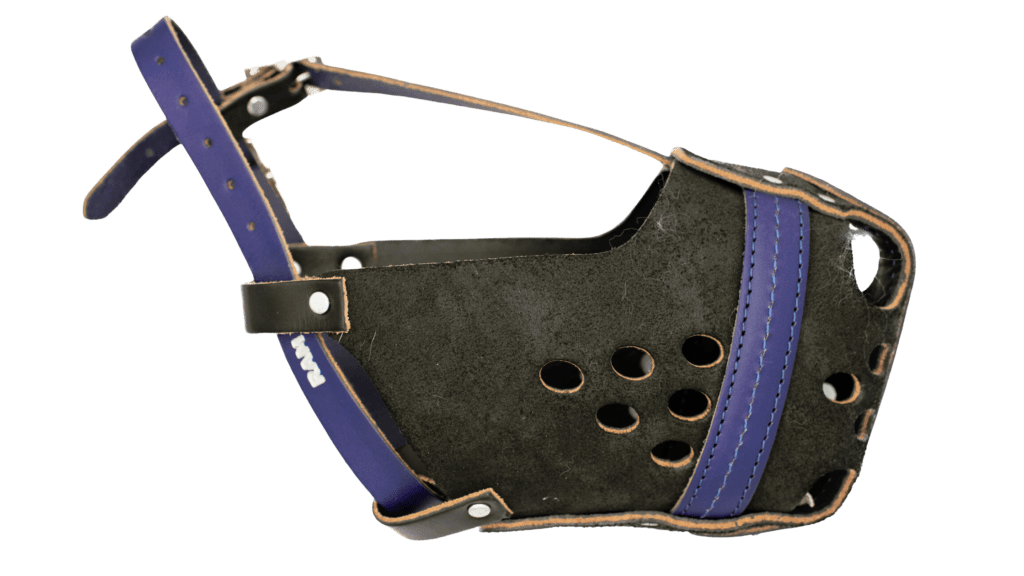
4. Agitation Muzzles
An agitation muzzle is likely the highest level of protection you can give for a dog who is a bite risk (or has a bite history) because it’s deliberately designed to mitigate a bite. Most dogs may find it difficult to get the correct size for these type of muzzles though, because they’re not one of the main types of dog muzzles and are specifically used in bite sports (hence why they’re super safe and secure!)
- Materials: Leather & metal
- Advantages:
- Entirely biteproof
- Strong
- Resilient
- Disadvantages:
- Limited applicability for dog breeds
- Can be a problem in hot/humid environments due to a lack of ventilation
- They absolutely remove all mouth based intra-canine communication.
- Because they’re leather they take a lot of care.
- Ideal for:
- German Shepherds/belgian malinois
- Cool environments
5. Biteproof Muzzles
- Materials: Leather, Vinyl
- Description: The difference between these and the agitation muzzles above is actually pretty slim, and they very much overlap – however the difference is usually agitation muzzles are deliberately designed for German Shepherds, Belgian Malinois, Dobermans and your typical “Bitesport” dogs. Because they are designed for bite work, they have added structure, i.e. steel bars encased within the leather
- Advantages:
- These muzzles (particularly the clear ones) are great for allowing effective canine communication.
- They’re lightweight
- Durable
- Biteproof
- Disadvantages:
- Low ventilation, consider not wearing in hot weather or humid conditions.
- They’re not easy to find
- Ideal for:
- Vet visits or unavoidable stressful situations that put others at risk
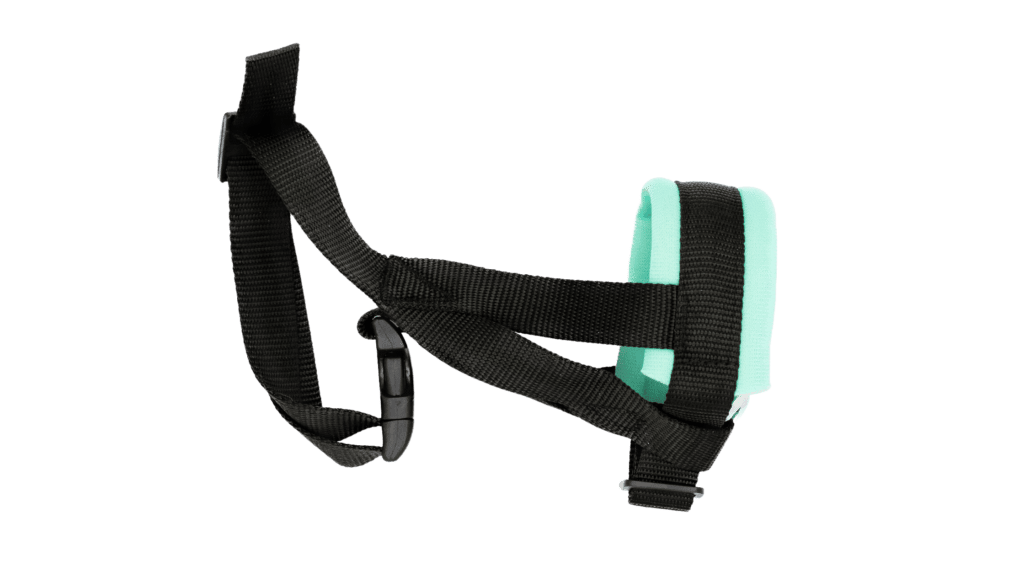
6. Often Misclassified Muzzles
This covers the ‘headcollars’ or head halters that get referred to as a muzzle, when they’re distinctly not muzzles as they do not prevent a bite and usually come with a leash attachment. A head halter is absolutely not a muzzle! And I really wish I could do something more than just help educate.
Material Types Explained
The material your muzzle use determines a lot of whether this is the best choice or even a good option for you and your dog — and it’s hard to know what’s right! And to make it worse certain muzzles make claims to be more a more “comfortable muzzle” and some muzzles (like wire dog muzzles) look really intimidating so we tend to steer clear, but just because of muzzle stigma, we shouldn’t let it deter us from getting the most appropriate muzzle for our dog to wear.
Leather
Most commonly found as leather basket muzzle or as fully enclosed biteproof agitation style muzzles. These muzzles are durable, but take a good bit of care. Leather dog muzzles (especially cheap, low quality ones) can perish easily when we
- Pros:
- Comfortable for dogs to wear
- Durable and long-lasting
- Custom-fitted to your dog’s face
- Look stylish
- Cons:
- Can be expensive
- Not as effective at preventing biting as basket muzzles
- May not allow dogs to pant as easily as basket muzzles
Plastic
The cheap, durable option. The most widely used of these is the baskerville muzzles, primarily the baskerville ultra (which is more durable than it’s predecessor)
- Pros:
- Affordable
- Lightweight
- Easy to clean
- Cons:
- May not be as comfortable for dogs to wear as other materials
- Can crack or break with excessive use
- Not as durable as other materials
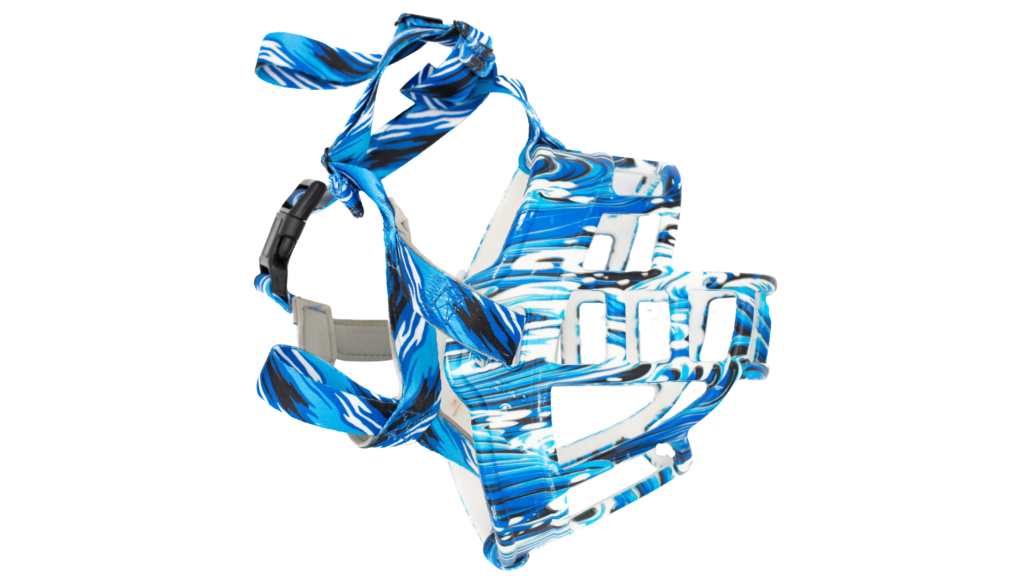
Rubber/Silicone
Rubber & Silicone is soft and flexible, making it a comfortable choice for dog muzzles. It is lightweight, waterproof, and easy to clean (you can literally throw it in the dishwasher), which are great attributes for a dog muzzle. Additionally, silicone is hypoallergenic and non-toxic, making it a safe choice for dogs with allergies or sensitivities, or even if consumed. However, I’m sure you’ve seen how your dog can take chunks off of a rubber toy — but rubber and silicone muzzles are not be as effective at preventing biting as metal or plastic basket muzzles.
These ones are an interesting, and honestly, whilst I know I said biothane works, I don’t feel like the silicone ones do (at least, I’ve yet to see one that does). Personally, I’d avoid silicone or rubber muzzles at this stage in their development.
- Pros:
- More comfortable for dogs to wear than plastic muzzles
- Lightweight
- Affordable
- Cons:
- May not be as durable as other materials
- Not as effective at preventing biting as basket muzzles
- May not allow dogs to pant as easily as basket muzzles
Wire/Metal
Wire muzzles are typically a basket style, but their use of metal means that it is one of the more secure types, particularly for large dogs or dog breeds with a high bite force. Quality metal muzzles won’t crack or break under the stress of dog bites, so long as we’re not deliberately testing then in situations like protection or bite sports.
- Pros:
- More durable than plastic or rubber muzzles
- Allow dogs to pant and drink water easily
- Cons:
- Can be uncomfortable for dogs to wear for extended periods of time
- May not be suitable for dogs with short faces, such as bulldogs or pugs
- Can be difficult to fit properly
Should I Opt For a Polymer Coating?
This is a really interesting question, because some brands claim it “winterizes” the wire basket muzzles, but I’ve discussed this quite midely in the muzzle community, and there is only one time that a polymer or plastic coating on a wire basket muzzle is beneficial, and that’s if you have a drooly dog breed (e.g. st. bernard)
Nylon
These are typically occlusion muzzles, i.e. they keep your dogs mouth completely shut. Sometimes they come in a mesh “bag” which is safer for dog wear and provides a good fit. It’s good to note that occlusion muzzles (or emergency muzzles) should not be used outside of an emergency setting as whilst they mitigate bite risk, they present serious safety risks for your dog (and your dog should never be unsupervised in an occlusion muzzle.
- Pros:
- Lightweight and comfortable for dogs to wear
- Affordable
- Easy to clean
- Cons:
- May not be as durable as other materials
- Not as effective at preventing biting as basket muzzles
- May not allow dogs to pant as easily as basket muzzles
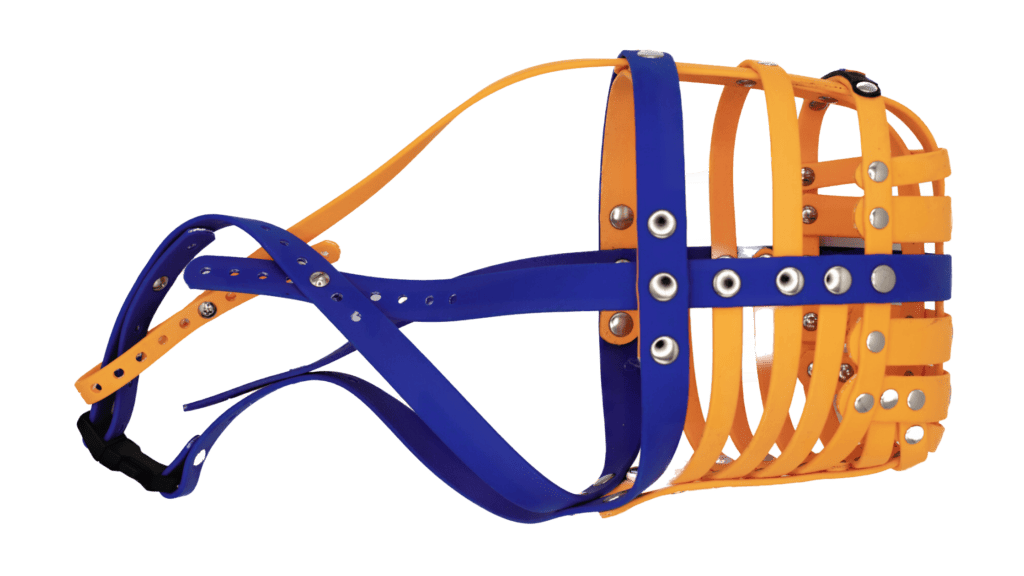
Biothane
Biothane is a synthetic material that is similar to leather but has several advantages over traditional leather. Biothane is waterproof, odor-resistant, and easy to clean, making it a popular choice for dog muzzles. It is also comfortable for dogs to wear and can be custom-fitted to your dog’s face. However, biothane can be more expensive than other materials and may not be as widely available. It is, however, widely available.
Biothane muzzles have really taken charge of my list of favourite basket dog muzzle – simply because of how light, user friendly and dog friendly they are. Critics will tell you that they’re not 100% biteproof — but few muzzles are. And I often recommend to my clients and to anyone who asks for advice that it depends on them. Typically, my dog parents are reactive dog parents who need a muzzle as an ultimate back up. The dog is already on leash, in a sturdy harness, wearing a safety strap, and collar, and on the instance that a dog runs up to them outside the dog park and isn’t under control and they just want that peace of mind — a biothane muzzle is going to do the job they want it to. The times you really need to focus on that biteproof status is for vet visits, for bitesports and similar. Because yeah, most dogs will figure out how to slip a muzzle, or break a muzzle if they’re given the time and ability to do so.
I’ll always advocate for practical dog parenting, and as a consequence, I do love the Biothane muzzles.
- Pros:
- Durable and long-lasting
- Waterproof and easy to clean
- Resistant to odors, stains, and bacteria
- Comfortable for dogs to wear
- Custom-fitted to your dog’s face
- Cons:
- Can be expensive compared to other materials
- May not be as widely available as other materials
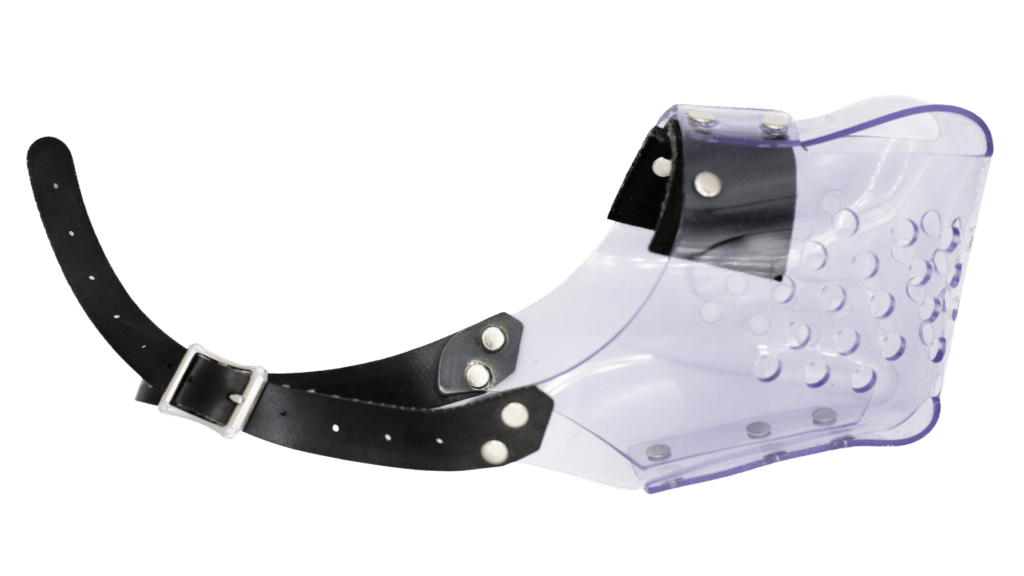
Vinyl
Vinyl is a synthetic material that is similar to plastic but softer and more flexible. It is often used to make dog muzzles because it is affordable, lightweight, and easy to clean. Vinyl muzzles are also comfortable for dogs to wear. However, vinyl is not as durable as other materials and may not be suitable for dogs who are heavy chewers or aggressive. Additionally, vinyl muzzles may not be as effective at preventing biting as basket muzzles.
- Pros:
- Affordable
- Lightweight
- Waterproof and easy to clean
- Durable
- Transparent ones offer unparalleled intra-canine communication.
- Biteproof
- Cons:
- Not as durable as other materials
- May not be suitable for dogs who are heavy chewers or aggressive
- Can create low ventilation (be acutely aware of signs of heat stroke)
What We Don’t Use Muzzles For
While a muzzle can be a useful tool in certain situations, there are also some instances where using a muzzle may not be appropriate or effective. Here are some things you should avoid using a muzzle for:
– Punishment: A muzzle should never be used as a form of punishment for your dog. Using it to muzzle your dog as a way of punishing them can cause fear and anxiety, leading to more behavioral issues in the long run.
– Prolonged use: A muzzle should not be used for extended periods of time, as it can cause discomfort, interfere with breathing, and lead to other health issues. It is important to give your dog regular breaks from wearing the muzzle to avoid any potential health issues.
– Solving behavioral issues: While a muzzle can be used as a tool to help manage certain behavioral issues in dogs, it should not be relied on as the sole solution. Muzzling your dog will not address the root cause of the behavioral issue and may even exacerbate the problem if used inappropriately.
– Chewing: Muzzles are not a solution to chewing! Especially if they’re unsupervised.
– Preventing barking: Muzzling your dog to prevent them from barking is not an effective solution. Not only can it cause discomfort and anxiety for your dog, but it also does not address the underlying cause of the barking behavior.
– Barking: A muzzle is not a good choice to prevent your dog from barking. Instead of focusing on preventing the bark, the best solution is to resolve the reason they’re barking instead. As a muzzle that will prevent barking, will be too tight for continued wear and could risk overheating, dehydration or choking
In summary, a muzzle should be used as a temporary tool to manage certain situations, but it is not a long-term solution to behavioral issues. It is important to use a muzzle appropriately and not rely on it as a punishment or a way to avoid addressing underlying issues.
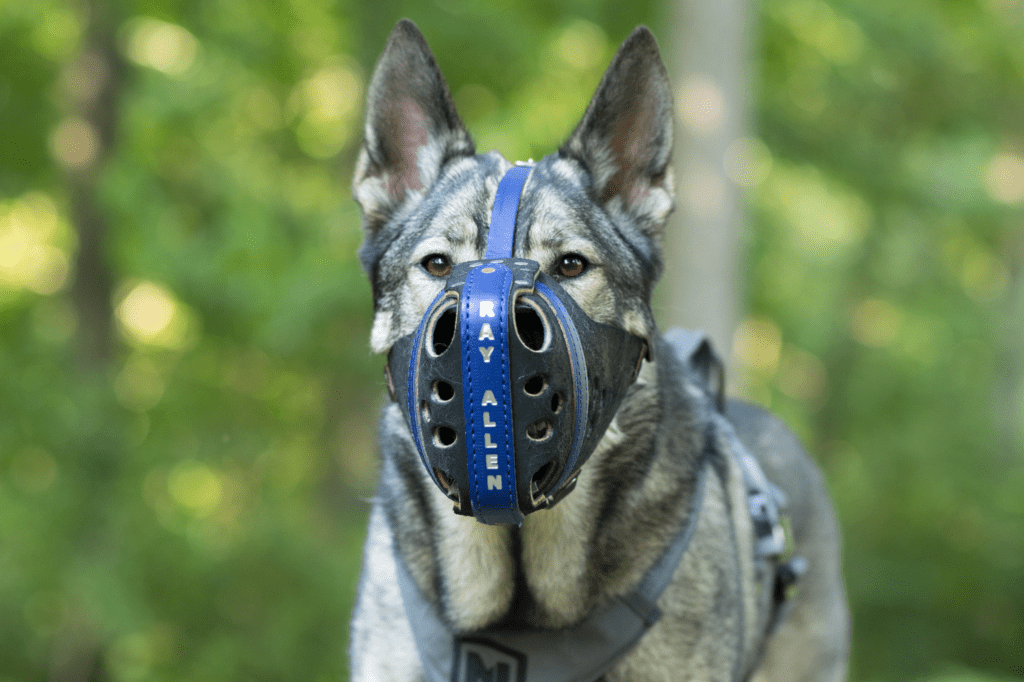
Muzzles are a responsible choice!
Muzzles are a very responsible and helpful tool for dog owners when used correctly. A Muzzled dog always belongs to a responsible dog parent.
Most of us use muzzles to prevent their dogs from biting, which in essence makes our dogs safer if a mistake or something unplanned happens, muzzles mitigate risk in specific situations. Just remember, they’re not designed to be worn for a long time, so start with only short periods of time, and build them back up to the length of your walk.
Overall, while muzzles might seem a little intimidating at first, they can be a really helpful tool for dog owners who want to keep their pets and other people and animals safe. Just make sure you’re using it correctly, and always pair it with positive reinforcement training to make sure your dog is comfortable and happy!
If you want to find the best muzzle for your everyday use with your wonderful dog, go check out our Best Muzzles — it’s actually the biggest tested list of muzzles on the internet!
Author, Ali Smith
Ali Smith is the Positive Puppy Expert, dog trainer and is the founder of Rebarkable. She is passionate about helping puppy parents get things right, right from the start. To help create a puppy capable of being a confident and adaptable family member and keep puppies out of shelters.
Ali has won multiple awards for her dog training, and has had her blog (this blog!) rated as 2021 & 2022 worlds’ best pet blog!
Thanks to depositphotos.com for the images!
